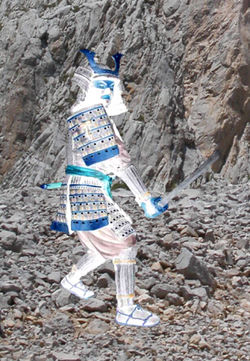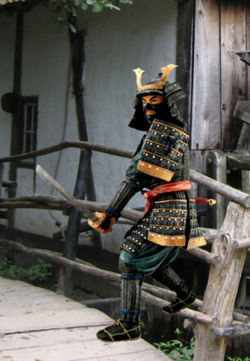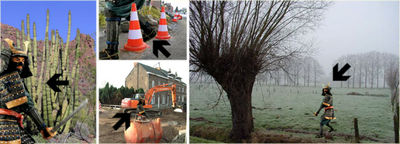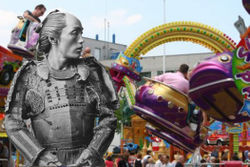The Real McCoy
“I am the Real McCoy.”
The Real McCoy (born 1663 in Albuquerque-to-be, USA) is the most famous offspring from a very ancient family of New-Mexican Samurais[1]. He's the real thing, he's immortal, and so are his father, Daddy McCoy, and his Evil Twin Brother, The Fake MacCoy.
Himself[edit | edit source]
McCoy's first name, "The Real", is derived from his father's business, which had nothing to do with samuraying anymore (see below... no, continue your read, it's riveting stuff!).
The Mission[edit | edit source]
The Real McCoy started very humbly, chasing tumbleweeds. To catch those silly little buggers, you need to make yourself invisible to them, and jump on them when they least expect it. Thus training himself to utmost discrecy and top notch agility, his eye fell on a copy of "El ingenioso hidalgo Don Quixote de la Mancha", by one Cervantes.[2] There he found his vocation: he would go through the world and save defenseless women and children. Unlike his Heroe, he never used a horse, and when Sherlock Holmes said: "Something is afoot!" he actually referred to The Real McCoy.
Habitat[edit | edit source]
The Real McCoy loves unspoiled nature, and dwells mostly in mountains, woods and deserts. As said before, the abilities developed during his tumbleweed training make him very hard to detect, as you can see below:
The Evil Twin[edit | edit source]
The Real McCoy wouldn't be such a super hero, if he hadn't got a real Evil Twin Brother. But he has, as real as his first name is The Fake. Nobody knows for sure who or what he was named after: some say he was called "The Fake" to distinguish him from his brother (see above... no, continue your read, I told you it's classy material!), others claim the name was taken from what the Mexicans (Old ones and New ones) called the products of their Daddy's competitors (see below... nooooo!). Like all decent bad guys, The Fake McCoy is clad in black..
No Mission[edit | edit source]
This sad piece of fakeness is spending his (and others') time, for centuries now, showing off with martial poses and glittering weaponry. But he ain't foolin' anyone! Failing to find a Mission, he found himself a composer who created a custom made tune, to be played whenever he came near people. He still spends lots of money hiring musicians wherever he comes, and every professional and semi-professional musician knows what to do when The Fake McCoy comes in. The musician who has seen him first shouts: "Bad Guy comin' in: minor key!", and thus cues to his tune.
Influences[edit | edit source]
Although there wasn't much nor anybody able to influence this lad, and he wasn't enough of a character to influence real bad guys, he did put some stamps after all:
Habitat[edit | edit source]
The Fake McCoy is attracted by technology, and is often seen in an industrial environment, which isn't necessarily a modern one: he has something with industrial archaeology. This is often explained as an attraction to primitive and especially clumsy manifestations of human progression. To pretentious to chase those silly tumbleweeds, he never developed his brother's gift for merging with his surroundings. That's why he always clashes with them, standing out as well, since you notice him very easily, because his aspect is very different. Oh, and yes, he likes pleonasms, unlike most readers eager to discover new and fresh knowledge. Look how he stands out:
Daddy McCoy[edit | edit source]
Old Daddy McCoy never adapted to the colourful world his sons evolved in, and neither did he like their colourful costume. He preferred the good old black & white world from his youth, when things were pretty much simple, and can nag Old McDonald for hours with stubborn despising but nonetheless very speaking silence.
Pottery[edit | edit source]
The Samurai business being very low in New-Mexico, Daddy McCoy decided soon to turn to another business: pottery. Although he was quite a talented potter, he had a hard time selling his products to the local Indian community. The foundation of the Spanish colonial post "Alburquerque"[3] boosted his output tremendously, and his products being sturdy, beautiful, classic and vanguardist all at once, his fame grew rapidly. So rapidly, that many competitors arose of similar, but inferior quality. That's why his artefacts were usually referred to as "The Real McCoy", and theirs as "The Fake McCoy".
Influences (in pottery)[edit | edit source]
The Old Wise Guy, as he was (and is) called, had a big influence on now famous pottery styles, and his black & white schemes are found on artefacts in the
- Acoma Pueblo Style
- Laguna Style
- Santo Domingo Style
- Bauhaus Style
- Ikea Style
Habitat[edit | edit source]
Some people never leave the town they were born in. Daddy MacCoy's case was quite the opposite: the town that developed around him never left him. It's still there, surrounding his quaint little shop. It still bears the original "Alfarería McCoy Pottery" sign, and sadly enough, he never had to change it into "McCoy & Son Inc.", his sons' careers heading totally different ways.
Seafood Notes[edit | edit source]
- ↑ More about this family and their arrival on the territory can be found in "The McCoy Family: From Humble Arrival To Eternal Immortality" by Isabel Reina de las Plantas Rodadoras, Squirmers Library, La Paz (Bolivia)
- ↑ McCoy's copy being one of the many copies of the first edition that went to the Americas, it is worth quite a buck nowadays. But he won't sell it, no señor!.
- ↑ The first "r" disappeared when McCoy took it out of his trade mark stamp, because his most popular mug line didn't have enough space at the bottom to contain the full "Made in Alburquerque" message. He thought nobody would notice the missing "r". Indeed: not only it wasn't noticed: people thought that was the correct spelling!






